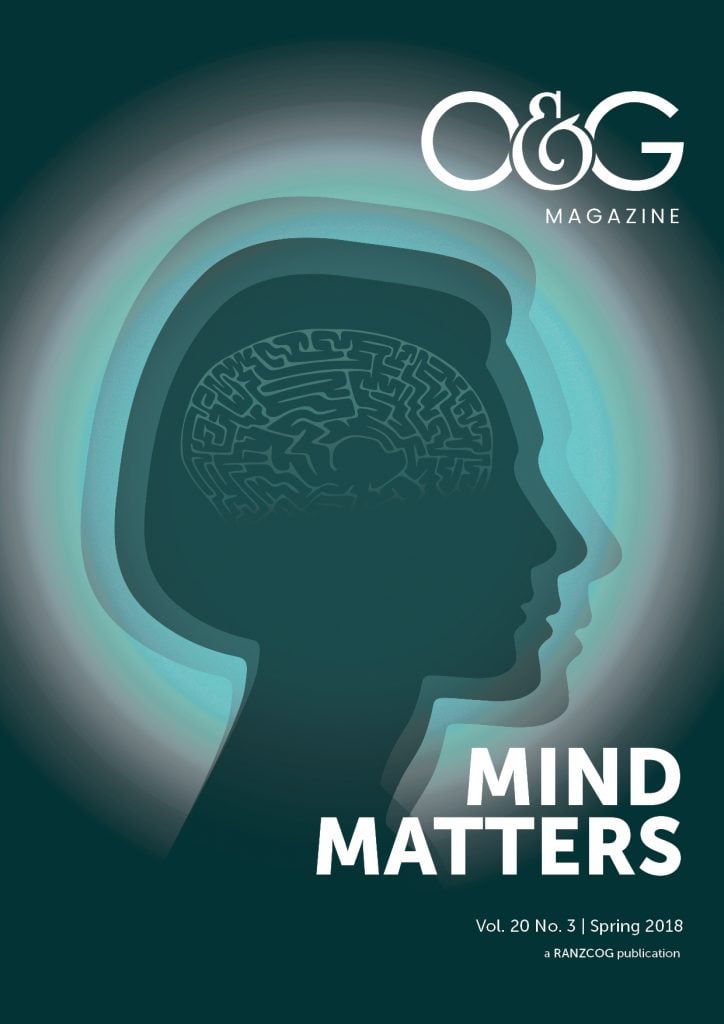‘The call to protect life – and not merely life but another’s identity – was obvious in its sacredness. Before operating on a patient’s brain, I realised, I must first understand his mind: his identity, his values, what makes his life worth living and what devastation makes it reasonable to let that life end. The cost of my dedication to succeed was high and the ineluctable failures brought me nearly unbearable guilt. Those burdens are what make medicine holy and wholly impossible: in taking up another’s cross, one must sometimes get crushed by the weight.’
– Paul Kalanithi, When Breath Becomes Air1
As I sit with my patient, supporting her towards the medical procedures that will interrupt her pregnancy just a few days after learning her baby has life-limiting abnormalities, I have the opportunity to ‘watch, wait and wonder’ about how this patient and her doctor have come to navigate this sad day. How their conversations on this day reflect previous conversations they’ve already had. This relationship, I notice, is bidirectional: to trust and to be trustworthy. It is conveyed verbally, of course, but mostly I notice the intensity of eye contact between them, the reassurance he offers when he touches her hand and the softness of his tone as he reminds her that she is safe. This doctor has had this conversation before; he is skilled, but not rehearsed. The difference between acting empathically and genuine empathy is obvious. It reminds me of other conversations between doctors and parents of infant patients who are not likely to graduate from our neonatal intensive care unit, or of those who have informed their patient of a terminal cancer diagnosis, or of the limits of reproductive assistance.
One of my senior neonatal colleagues offers her reflections on the meaning of bad news and how this meaning is represented in conversations differently for each patient:
‘I remember distinctly how anxious I felt about how to best broach this [dysmorphic features of trisomy 21] with mum, who was overjoyed by the live birth of her baby after so many losses. I started talking to mum gently and to the best of my ability, with a reassuring tone, though my thoughts were racing. I must have put a lot of numbers into my monologue, as mum’s only comment was, ‘Thank you, doctor. I love him as he is. At least he is here to fulfil my empty life’. Since this first attempt, and after plenty of self-reflection, I come to these conversations now with more compassion. Each time I come away emotionally drained, and I have, on occasion, shed a tear with my patients, sharing in their pain. I believe this is the purest form of human emotion and as a doctor I am human too. I have been observer and leader of these consults and often think about what my juniors must think of me, possibly that I am weak and unable to offer that strong, calm face. However, over time, I have found it helpful to develop a clear and open stance toward the family’s beliefs and values, helping them to draw meaning and make decisions that fall in line with their values by painting the most honest picture of the condition that I can. Patients remember different things about these conversations. I have come to value that what I can offer, always, is kindness and compassion.’
Bad news risks interrupting a patient’s sense of self, relationships, future, values and hope. This disruption can cause intense pain. It is a moment by moment unfolding of meaning and it is inescapable. From the auxiliary posture of the clinical psychologist working in healthcare, therapeutic principles of Carl Rogers’ person-centred practice offer a way of organising the interpersonal texture of the conversation between doctor and patient. What my colleagues in these vignettes demonstrate, perhaps without self-consciousness, is their capacity to ‘see’ the person before them and place a higher order value on the ‘holding’ in their helping relationship. This approach reflects a departure from a more linear transaction of medicine (giving facts) and gives place to translation of meaning.
While there seems to be a common structure to the pitch of ‘illness’ conversations across clinical contexts, in itself, structure and content is not sufficient. It seems from the outside, through observation and involvement in simulation training and peer consults, that it is rarely a lack of knowledge about particular conditions, diagnosis or prognosis that concern our trainees. They are concerned with how to deliver their knowledge while maintaining compassion and hope, all in the context of the patient’s fear and the doctor’s own experience of feeling vulnerable. It can be helpful to think about these communication skills as stages of development in the life of the doctor. In early professional development, teaching about content and structure takes priority. In advanced trainees, the interpersonal process comes into sharper focus.
Delivering unsettling news
The practice-informed and evidence-based literature contains useful communication strategies for delivering sad and illness-related information that makes up mandatory reading for all healthcare professionals, whether they fulfil direct or supportive roles. Within this literature you will find structural guidelines for critical conversations:
- Prepare the setting, the message and yourself
- Start by assessing the patient’s existing understanding of their situation
- Deliver information clearly and slowly
- Become familiar with common emotional and stress responses
- Give patients permission to ask questions, invite their family
- Be curious about the impact of illness on the patient’s life
- Summarise information into two to three key points
- Make a plan to follow-up.
More broadly, communication skills training for senior trainees are encouraged through experiential-led training options. Conceptual distillation of micro-counselling skills has emerged in recent literature. For example, Back et al recommend avoiding ‘blocking, dismissing or redirecting’ habits, lecturing, colluding and premature reassurance.2 Instead, these authors encourage their reader to cultivate skills such as ‘ask-tell-ask’, expansive questioning (for example, tell me more), naming and validating emotional responses.
The relationship
Whatever structure and counselling techniques are followed, or the clinical context, the best examples of critical conversations are characterised by something special in the space that sits between a doctor and their patient, between the lines of the words spoken. This human binding agent might be best described as relational dynamics. It involves empathy, a capacity to be authentic and wholly present, and an unconditional preparedness to see the world view of the person before you. To facilitate at this conversational level, we must be available to ‘see’, as wholly as possible, the patient’s understanding, decisions, intentions and proposals, emotions, beliefs and thoughts. The bad news consult is not a time to defend a diagnosis or expertise, but to bear the patient’s pain (expressed in whatever form) by recognising that illness transforms lives. Indeed, the doctor’s capacity to support a patient’s adjustment to bad news is best served from a position of curiosity about the person being treated, rather than from the more closed position of knowing. This reflective and reflexive interpersonal process offers the opportunity to consider the unique qualities of the patient that serve to potentiate, enable and extend themselves to cope with bad news and its meaning. Learning to feel comfortable with the ‘holding’ space is reflected in another of my colleague’s comments about the role of silence:
‘Even now, after 20 years working in neonatal medicine, I approach these conversations with a sense of trepidation, as I am acutely aware that the parents’ lives will be forever changed. I have learned not to be afraid of silence. A period of silence is often “right” as it conveys respect for the enormity of the news. Taking time to explore with parents what the news means for them is as important as getting the facts correct. This allows decisions to be made without rushing.’
Any suffering has the power to transform lives. Suffering comes in many forms. The doctor’s duty is not to return a patient to a previous life, but instead, to hold and contain projections of the person’s unbearable feelings, while they take up the space to think through and understand what makes up their experience; and ultimately, what will come to carve out their new normal.
Hope
Never destroy a patient’s hope. Through exploring perceptions we widen our lens for possibility. Hope may be found in many places, even in the face of despairing odds. Doctors often view hope through a different lens from their patients, as an expression of statistical likelihood, rather than an expression of wishing. Hope is found in the quality of the living; of a motherhood story (however short); of a relational experience, in broader reflections about the life lived. Searching for hope in the face of despair is a delicate art form of ‘meaning-making’ and central to illness-related conversations in medicine. While hope may reflect a period of denial as the patient seeks to maintain a protective stance, as they develop readiness to ‘hear’ the bad news, it can also be about the emergence of a new beginning, a wish for a different future. Hope prepares the ground for healing, movement, change, acceptance and, ultimately, growth.
Further reading
- Kalanithi P. How long have I got left? New York Times. Available from: www.nytimes.com/2014/01/25/opinion/sunday/how-long-have-i-got-left.html.
- Back A, Arnold R, Baile W, et al. Approaching difficult communication tasks in oncology. CA: Cancer Journal for Clinicians. 2005; 55(3):164-77. Available from: https://doi.org/10.3322/canjclin.55.3.164.
- Kier A, Wilkinson D. Communication skills training in paediatrics. Journal of Paediatrics and Child Health 2013;49:624-28.
References
- Kalanithi P. When breath becomes air. United Kingdom: Random House; 2016.
- Leone D, Menichetti J, Barusi L, et al. Breaking bad news in assisted reproductive technology: a proposal for guidelines. Reproductive Health 2017; 14: 87. Available from: https://reproductive-health-journal.biomedcentral.com/articles/10.1186/s12978-017-0350-1.






Leave a Reply